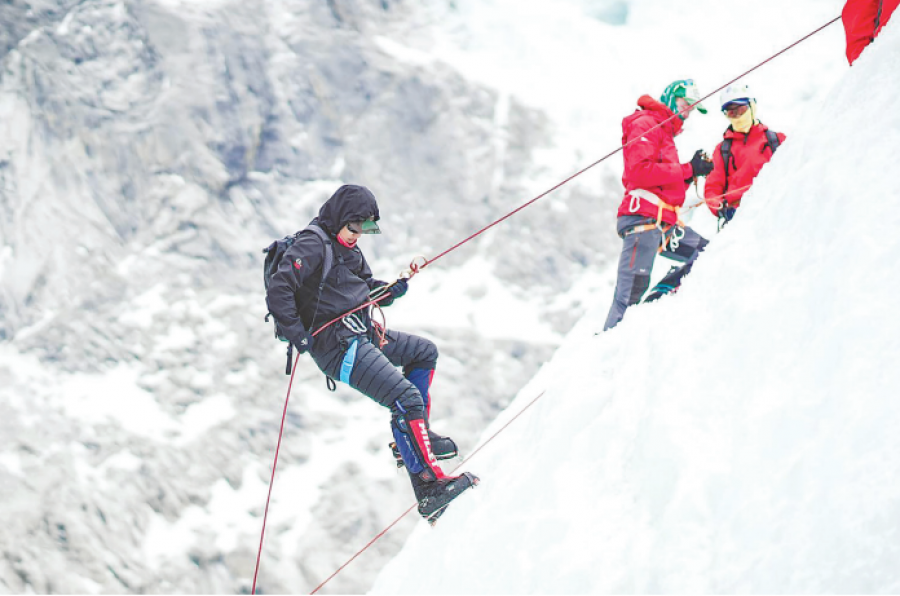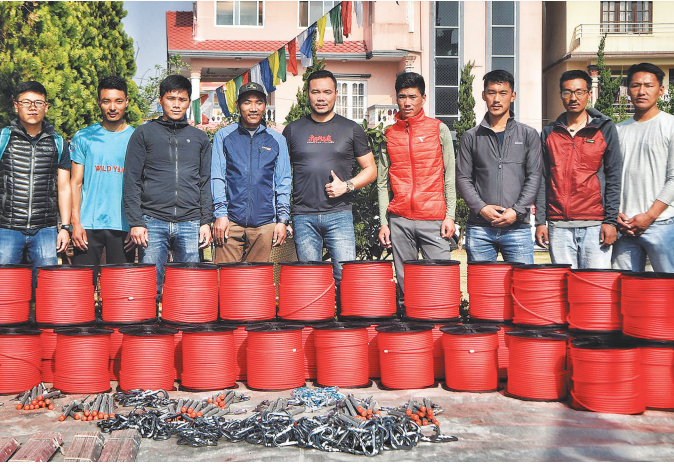
Record-setting mountaineer Kami Rita Sherpa didn’t find any fixed ropes in the “death zone” on Mt Everest when he climbed the peak in the spring. Sherpa, who holds the world record for summiting 8,000-metre mountains an astounding 39 times, knows the value of the ropes for climbers crawling up the frozen slopes.
Every year, expert sherpas fix hundreds of kilograms of ropes leading to the top of the Himalayan peaks to help climbers following them. But what happens to these nylon ropes after the end of the mountaineering season?
“They are usually left on the mountain,” said Himal Pandit, training coordinator at the Nepal Mountain Academy established by the Tourism Ministry.
“Around 400 kg of plastic ropes are left on the mountain every year, and they remain there for decades. There is no policy to bring them down, and this has been polluting the mountains,” he said, speaking at the International Sustainable Mountain Tourism Conference in Kathmandu on Thursday.
Everest is a cash cow for the government. Climbers pump billions into Nepal’s economy annually. Around 60,000 trekkers visit Everest base camp alone to gaze in awe at the world's highest peak, energising the economy all along the trail. But the government has no policy to keep the mountain clean, observers say.
Kami Rita, who has been climbing since 1994, told the Post, “In the past, if we saw any ropes, we would bring them down to the base camp and pass them around. They are good for tying yaks and cows. “I don’t know how much rope lies buried on the peak. It could be a lot.”
Pandit has been doing research on mountain pollution caused by plastic ropes. He has interviewed more than 20 high-altitude climbing sherpas.
“The sherpas say it’s not their responsibility to remove the ropes by risking their lives. We have estimated that there are ropes from 30 to 40 years ago. The government has a policy to fix the ropes, but there is no clear policy to remove them.”
According to Pandit, around 50 tonnes of ropes are estimated to lie buried under the snow on different mountains of Nepal.
There are risks in bringing the ropes down in the same season. “Besides, sherpas are not paid to bring them back. They are paid to fix the ropes only,” said Kami Rita.
“So it’s the responsibility of the sherpas who fix the ropes the following year to bring down the old ropes.”
According to Kami Rita, the rope-fixing team can’t wait for an expedition to finish. So the ropes are either blown away by the wind or swept down by avalanches and lie buried under the snow.
Dambar Parajuli, president of the Expedition Operators Association of Nepal, says ropes are fixed on Everest in two different systems.
From the Khumbu Icefall at the head of the Khumbu Glacier at 5,486 metres to Camp II at 6,400 metres, the ropes are fixed by icefall doctors deployed by the Sagarmatha Pollution Control Committee, a community-based NGO.
The committee charges $600 per climber for the service. These ropes are normally removed.
For the section from Camp II to the summit at 8,848.86 metres, the Expedition Operators Association of Nepal calls for applications from the expedition companies to fix the ropes.
“This system was introduced in 2014, but it was only fully implemented in 2016,” said Parajuli. “Before that, ropes used to be fixed through mutual understanding between the expedition operators.”
The operators had to contribute sherpas and logistics to fix the ropes.
According to Parajuli, it costs more than Rs10 million to fix the ropes, and on Everest, around 1,300 metres of rope is required. Beal climbing ropes are normally used for climbing.
Parajuli says they have a clear contract with the expedition operator who wins the contract to bring back the old ropes while fixing a new set.
“To avoid confusion about which is which, we use ropes of a different colour every year. If we have used red ropes in 2021, we use yellow ropes in 2022,” he said.
According to him, removing the ropes is a super difficult task. “It’s almost impossible to search, dig and fasten them. And we can’t risk a sherpa's life. So, they are left on the mountain.”

A file photo shows climbers from Seven Summit Treks with spools of climbing rope ahead of Everest climbing season. Photo Courtesy: Seven Summit Treks
The litter left behind by visitors has long been a burden on the Everest region. Hundreds of mountaineers, sherpas, guides and other high altitude porters bound for Everest leave behind tonnes of both biodegradable and non-biodegradable waste, like empty oxygen canisters, bottles, ropes, kitchen waste and faecal matter, polluting the area and settlements downstream.
Plastic is a non-biodegradable material and most plastic is made from fossil fuels. If burnt, it poisons the air; if buried, it pollutes the soil. Plastic has been creeping up the mountains due to the increasing number of mountain climbers, mostly on the world’s highest peak Everest.
A conservative estimate puts the average time for one single plastic bag to completely biodegrade at 500 years.
A sherpa earns Rs900,000 to Rs1 million fixing ropes on Everest. It takes five to six days, depending on the weather. The expedition organiser says the old ropes mark the route which is a help to the rope fixers.
Over the years, plastic has created havoc in the Everest region. The trek from Lukla to Everest base camp has long been referred to as “garbage of toilet paper”. There is a big problem of human waste in the Khumbu area, and it has been polluting the water for people living downstream.
Nearly 60,000 trekkers travel to Khumbu annually, leaving behind massive pollution.
There is a government rule requiring every climber to bring back at least 8 kg of garbage—the amount of trash estimated to be produced by one climber—but it hasn't been very effective.
“Garbage on the mountain is challenging, but it is a solvable problem. There is a solution,” said Alton C Byers, a mountain geographer, conservationist and mountaineer, while presenting a paper entitled "Notes from the Field: Contemporary Social and Physical Changes in Nepal’s High Mountains" at Thursday’s conference.
“Two decades ago, when I visited Khumbu, there was no garbage in any village,” said Byers, a professor at the University of Colorado. “Now, due to modern life, plastics are everywhere. Every food and beverage comes in plastic.”
He said that tourism in Khumbu had grown tremendously, and along with that the number of lodges is growing and growing. “This brings garbage.”
Since January 2020, Khumbu Pasang Lhamu Rural Municipality in Solukhumbu district has banned the use of plastic bags, bottles and other plastic items, citing their adverse effects on human health, especially in the Everest region. The use of plastic bags of less than 30 microns has been prohibited.
“But plastic is climbing up the mountain. This is a serious issue,” said Buddhi Sagar Lamichhane, joint secretary at the Tourism Ministry. “I hope the issue will get traction.”












